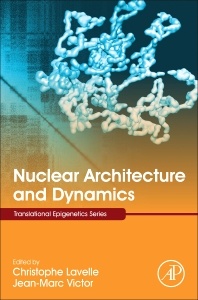Nuclear Architecture and Dynamics Translational Epigenetics Series
Coordonnateurs : Lavelle Christophe, Victor Jean-Marc

Nuclear Architecture and Dynamics provides a definitive resource for (bio)physicists and molecular and cellular biologists whose research involves an understanding of the organization of the genome and the mechanisms of its proper reading, maintenance, and replication by the cell. This book brings together the biochemical and physical characteristics of genome organization, providing a relevant framework in which to interpret the control of gene expression and cell differentiation. It includes work from a group of international experts, including biologists, physicists, mathematicians, and bioinformaticians who have come together for a comprehensive presentation of the current developments in the nuclear dynamics and architecture field.
The book provides the uninitiated with an entry point to a highly dynamic, but complex issue, and the expert with an opportunity to have a fresh look at the viewpoints advocated by researchers from different disciplines.
PART I - CHROMATIN ORGANIZATION AND DYNAMICS 1. DNA mechanics 2. DNA supercoiling (omics) 3. Chromatin and chromosome folding (experiments) 4. Chromatin and chromosome folding (modeling) 5. Chromatin and chromosome physics 6. ncRNA in chromatin folding 7. Insulators 8. Condensins and cohesins 9. Long range interactions 10. Crowding
PART II - NUCLEAR ENVELOPE, NUCLEAR BODIES AND NUCLEOCYTOPLASMIC TRAFFICKING 11. Nuclear bodies 12. Nucleolus 13. Transcription factories 14. Polycomb bodies 15. Nuclear lamina 16. Other components of the nucleoskeleton 17. Nuclear pores 18. Nuclear traffic
PART III - MAIN NUCLEAR FUNCTIONS 19. Chromatin folding and DNA replication 20. Chromatin folding and DNA repair 21. Chromatin folding and transcription 22. Chromatin folding and recombination 23. Chromatin folding and differentiation 24. Nuclear mechanics and mechanotransduction 25. Altered nucleus and disease
PART IV - SPECIFIC FEATURES OF NUCLEAR ORGANIZATION IN MAIN MODEL ORGANISMS 26. Yeast nucleus 27. Nematode nucleus 28. Drosophila nucleus 29. Plant nucleus Conclusion and perspectives by the editors
Jean-Marc Victor, Volume Editor, is a research director at the CNRS, principal investigator at the University Pierre et Marie Curie - Paris VI (part of Sorbonne University). His studies mostly concern the physics of chromosomes (theory and simulations) and the modeling of nuclear processes, with special attention to epigenetics and chronic diseases.
- Highlights the link between the (bio)chemistry and the (bio)physics of chromatin
- Deciphers the complex interplay between numerous biochemical factors at task in the nucleus and the physical state of chromatin
- Provides a collective view of the field by a large, diverse group of authors with both physics and biology backgrounds
Date de parution : 10-2017
Ouvrage de 618 p.
19x23.3 cm
Mots-clés :
30-nm chromatin fiber; 3D genome organization; Anomalous diffusion; Antigen receptor loci; CTCF; Caenorhabditis elegans; Cajal bodies; Cancer; Chromatin; Chromatin activation; Chromatin architecture; Chromatin assembly; Chromatin dynamics; Chromatin fibers; Chromatin looping; Chromatin loops; Chromatin modifications; Chromatin remodeling; Chromatin topology; Chromosome; Chromosome conformation capture; Chromosome folding; Chromosome territories; Coarse-grained modeling; Cohesin; Computer simulat



